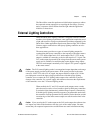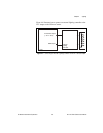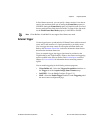
© National Instruments Corporation 5-1 NI 17xx Smart Camera User Manual
5
Image Acquisition
This chapter contains information about acquiring images with the
NI Smart Camera and explains the relationships between triggering,
lighting, and exposure.
Exposure
The NI Smart Camera provides control of the image sensor exposure time
through software. The exposure time is the amount of time that light is
allowed to strike the sensor to produce an image. When light strikes the
surface of the sensor, it dislodges electrons. As more light strikes the
sensor, more electrons are freed, creating a charge on the sensor.
For a given amount of light, the sensor collects more charge during a longer
exposure time than a shorter exposure time. Because the charge is what is
read out to produce the image, it is important to have an optimal amount of
light and exposure time for your application.
Exposing the image sensor for too short of a time relative to the amount of
light in the environment results in a dark, low contrast image. Exposing the
image sensor for too long of a time relative to the amount of light in the
environment results in a bright, low contrast image. When the image sensor
is exposed for an appropriate amount of time relative to the light in the
environment, acquired images will exhibit appropriate contrast to easily
distinguish both dark and light features. Contrast is a key factor in obtaining
good results from image processing algorithms.
In applications where the object under inspection is moving, the exposure
time must be carefully considered. If the object moves significantly during
the exposure, the resulting image is blurry and unsuitable for processing.
The maximum exposure time for imaging a moving object without blurring
depends on the per pixel spatial resolution and the rate of motion of the
object. The per pixel spatial resolution is the field of view, calculated in
the Field of View section of Chapter 3, NI Smart Camera Image Sensor,
divided by the number of pixels in the sensor. Together, this information


















